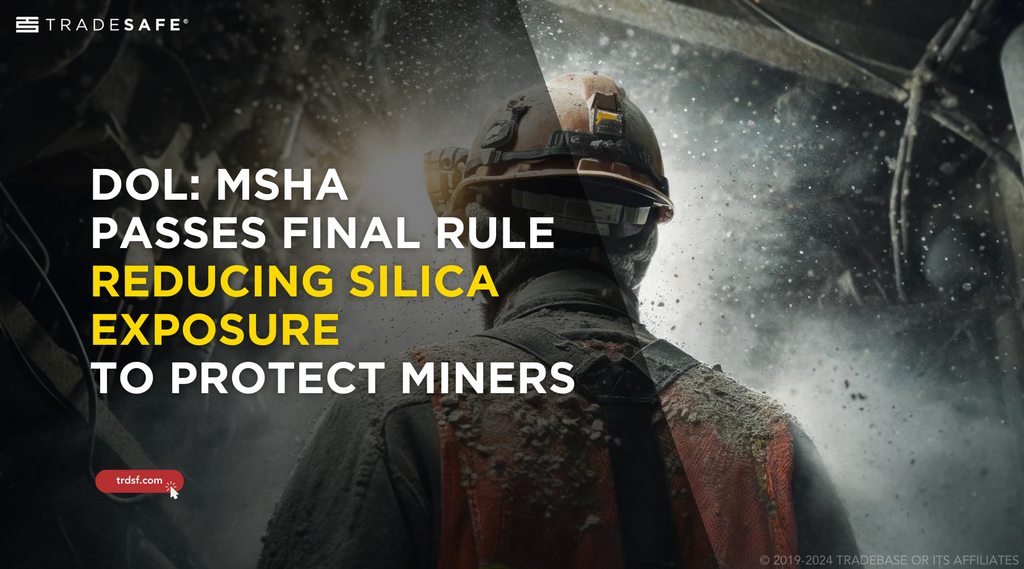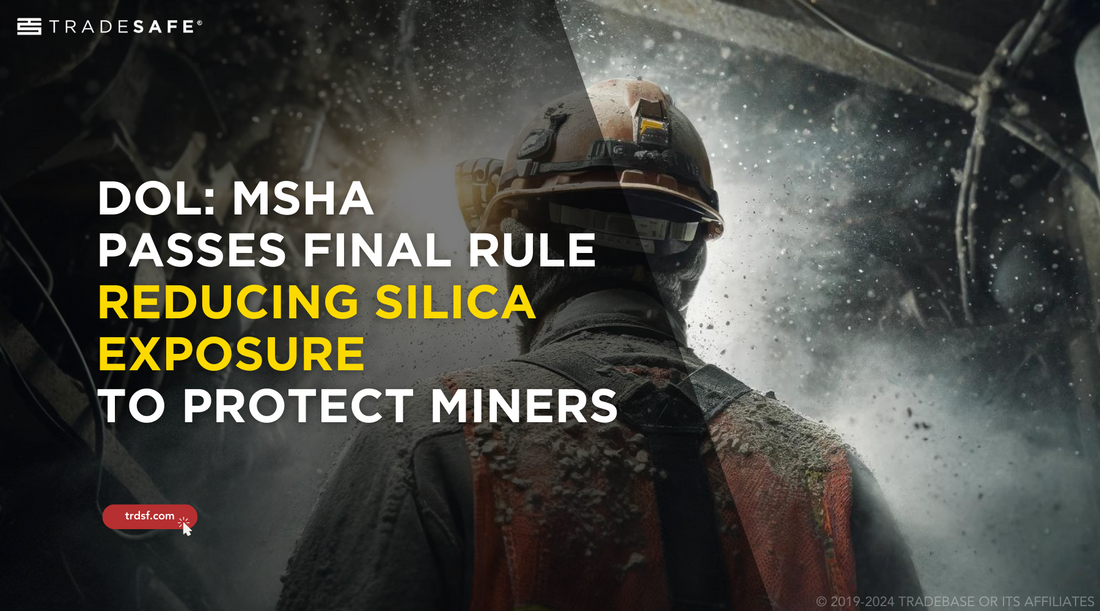
In a significant move by the U.S. Department of Labor, new MSHA regulations have been set to protect miners from silica exposure. Known for its serious health risks, silica exposure has long been a concern in mining environments. The updated MSHA silica standard lowers the allowed amount of silica dust in the air, marking a crucial step forward in safeguarding miners' health. This article discusses the details of the new rule and its expected impact on the mining industry.
Understanding Silica Exposure and Its Dangers
Respirable crystalline silica is a very tiny particle, much smaller than a grain of sand, that comes from materials like rock, sand, and concrete. When these materials are cut or crushed, the dust released can be breathed in, causing various health issues. This kind of silica exposure is particularly common in industries like mining and construction. Under new MSHA regulations, the focus is on reducing this dangerous silica dust exposure to improve worker safety.
Silica exposure can lead to several serious health conditions:
- Silicosis: An incurable lung disease that causes scar tissue to form in the lungs, reducing the ability to breathe.
- Lung cancer: Long-term exposure to respirable crystalline silica has been linked to an increased risk of developing lung cancer.
- Chronic obstructive pulmonary disease (COPD): Inhaling silica dust can lead to chronic bronchitis and emphysema, types of COPD.
- Kidney disease: There is evidence that prolonged silica exposure may also cause damage to the kidneys.
- Progressive massive fibrosis: This severe condition results from scarring of the lung tissue caused by silica dust, making breathing extremely difficult.
Details of the New MSHA Silica Standard
The Department of Labor has established stringent new guidelines under the MSHA silica standard to control silica dust exposure in mining operations. The centerpiece of these regulations is the revised permissible exposure limit (PEL) for respirable crystalline silica, which is now set at 50 micrograms per cubic meter of air. This limit is based on an 8-hour time-weighted average, making it a more accurate reflection of the silica exposure miners face during a typical work shift.
When this limit is exceeded, the new MSHA regulations require mine operators to take immediate corrective actions. These actions are crucial for preventing the long-term silica side effects that can severely impact a miner's health. Acting Secretary Julie Su emphasized the critical nature of these changes, stating, "It is unconscionable that our nation’s miners have worked without adequate protection from silica dust despite it being a known health hazard for decades.”
Assistant Secretary for Mine Safety and Health Chris Williamson highlighted the long-term benefits, saying, “This rule reducing miners’ exposures to toxic silica dust has been a long time in the making, and the nation’s miners deserve its health protections.”
Protective Measures and Engineering Controls
To effectively reduce silica exposure and mitigate silica side effects, the new MSHA silica standard introduces specific engineering controls along with updated respiratory protection measures.
Engineering controls are crucial for limiting silica exposure in mining environments. These include the use of water sprays to dampen dust at the source and ventilation systems designed to capture airborne silica particles. Such measures are essential to ensure that silica dust does not become airborne where miners can inhale it.
Additionally, the updated MSHA silica standard mandates the adoption of the latest respiratory protection standards. This update reflects the most recent advances in respiratory protection technology and practices, providing miners with enhanced protection against silica and other airborne hazards.
Health Examinations and Medical Surveillance
The updated MSHA silica standard also emphasizes the importance of health examinations and medical surveillance for miners.
Under the new rules, metal and nonmetal mine operators are required to provide periodic health examinations to monitor the effects of silica exposure. These examinations are critical for early detection of silica-related illnesses, allowing for timely intervention and treatment. The health exams must be conducted at no cost to the miners, ensuring that every worker has access to essential health services without financial burden.
This initiative aligns with existing programs for coal miners, which have historically included medical surveillance to protect against coal dust. However, the new MSHA silica standard broadens the scope of surveillance to include non-coal miners, reflecting a comprehensive approach to occupational health across the entire mining industry.
Here's a table summarizing the key details of the new rule on silica exposure:
| Aspect of the Rule | Details |
| New Exposure Limits | The permissible exposure limit (PEL) for respirable crystalline silica is set at 50 micrograms per cubic meter of air for an 8-hour time-weighted average. |
| Immediate Corrective Actions | If silica dust levels exceed the new limits, mine operators must take immediate action to reduce the silica dust exposure and return to compliance. |
| Engineering Controls | Mine operators are required to implement engineering controls to prevent overexposure to silica dust. |
| Medical Surveillance Programs | Metal and nonmetal mine operators must establish medical surveillance programs to provide periodic health examinations at no cost to miners. |
| Updated Respiratory Protection | The rule updates the standard for respiratory protection to reflect advances in technology and practices, ensuring better protection against airborne hazards. |
Impact of the New MSHA Regulations
The new MSHA silica standards are set to have a profound impact on miners' health by significantly reducing silica exposure and the related risks:
- Decrease in Silicosis Cases: By reducing silica dust exposure, the new rule aims to lower the incidence of silicosis, an often-fatal lung disease caused by inhaling silica particles.
- Reduction in Lung Cancer Rates: With stricter control on silica exposure, it is anticipated that there will be fewer cases of lung cancer among miners, directly linking improved workplace conditions to better long-term health outcomes.
- Fewer Cases of Chronic Bronchitis and COPD: Enhanced dust control measures will help prevent chronic respiratory diseases like bronchitis and chronic obstructive pulmonary disease among the mining workforce.
- Reduction in Progressive Massive Fibrosis: Stricter silica exposure limits will help decrease the number of cases of progressive massive fibrosis, a severe lung condition resulting from extensive scarring due to silica inhalation.
FAQs on Silica Exposure and Regulations
Where can you be exposed to silica?
Silica exposure primarily occurs in industries involving cutting, grinding, or drilling silica-containing materials like concrete, stone, and sand. Key exposure sites include construction sites, mines, foundries, and manufacturing facilities handling these materials.
How much exposure to silica dust is dangerous?
Any amount of respirable crystalline silica dust can be harmful, but exposure above the permissible exposure limit (PEL) of 50 micrograms per cubic meter of air over an 8-hour workday is considered particularly dangerous and requires corrective action.
Is silica bad for you?
Yes, silica can be harmful when inhaled as it leads to the development of various serious health conditions, including silicosis, lung cancer, chronic obstructive pulmonary disease (COPD), and kidney disease.
What is the proposed silica standard for MSHA?
The proposed MSHA silica standard sets the permissible exposure limit (PEL) for respirable crystalline silica to 50 micrograms per cubic meter of air, calculated over an 8-hour time-weighted average.
What is the standard for silica exposure?
The standard for silica exposure, as set by the latest MSHA regulations, is a limit of 50 micrograms per cubic meter of air over an 8-hour workday.
What is the exposure limit for silica in MSHA?
The exposure limit for silica under MSHA regulations is 50 micrograms per cubic meter of air for an 8-hour time-weighted average.
What is the maximum allowable concentration of silica?
The maximum allowable concentration of silica, according to the new MSHA silica standard, is 50 micrograms per cubic meter of air over an 8-hour shift. This is designed to significantly reduce health risks associated with silica dust.
TRADESAFE is a leader in providing top-tier industrial safety solutions, including Eye Wash Stations, Workplace Signs, and more, all precision-engineered to meet rigorous safety standards.
